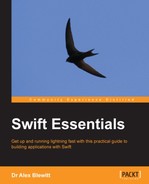Book Description
Get up and running lightning fast with this practical guide to building applications with Swift
In Detail
Swift is a new and powerful programming language that represents an essential new programming tool for iOS and OSX applications and builds upon the power of Objective-C while streamlining the developer experience.
Swift Essentials is a fast-paced, practical guide showing you the quickest way to put Swift to work in the real world. It guides you concisely through the basics of syntax and development before pushing ahead to explore Swift's higher features through practical programming projects.
By the end of the book, you will be able to use Xcode's graphical interface builder, create interactive applications, and communicate with network services.
What You Will Learn
- Explore the nuts and bolts of the Swift syntax
- Test Swift code interactively with the REPL
- Display graphics with QuickLook in the Swift playground
- Present data in master-detail applications
- Use the Swift storyboard to manage multi-screen applications
- Create graphical UIViews with Swift
- Parse JSON and XML data from network sources
- Build a standalone iOS application from start to finish
Downloading the example code for this book. You can download the example code files for all Packt books you have purchased from your account at http://www.PacktPub.com. If you purchased this book elsewhere, you can visit http://www.PacktPub.com/support and register to have the files e-mailed directly to you.
Table of Contents
- Swift Essentials
- Table of Contents
- Swift Essentials
- Credits
- About the Author
- Acknowledgments
- About the Reviewers
- www.PacktPub.com
- Preface
- 1. Exploring Swift
- 2. Playing with Swift
- 3. Creating an iOS Swift App
- 4. Storyboard Applications with Swift and iOS
- 5. Creating Custom Views in Swift
- 6. Parsing Networked Data
- 7. Building a Repository Browser
- A. Appendix
- Index
